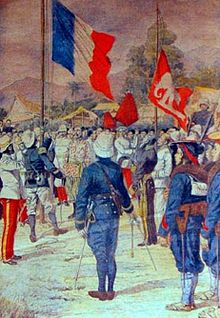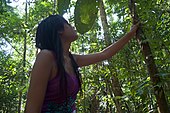Trat province
Trat ตราด | |
|---|---|
 | |
| Motto(s): เมืองเกาะครึ่งร้อย พลอยแดงค่าล้ำ ระกำแสนหวาน หลังอานหมาดี ยุทธนาวีเกาะช้าง สุดทางบูรพา ("The city of half a hundred islands. Precious rubies. Sweet salacca. Fine Thai ridgeback dogs. The Naval Battle of Ko Chang. The far end in the East." | |
 Map of Thailand highlighting Trat province | |
| Coordinates: 12°24′N 102°31′E / 12.400°N 102.517°Ecenter of province | |
| Country | Thailand |
| Capital | Trat |
| Government | |
| • Governor | Nutthapong Sanguanchit (since December 2023) |
| Area | |
• Total | 2,819 km2 (1,088 sq mi) |
| • Rank | Ranked 62nd |
| Population (2019)[2] | |
• Total | 229,958 |
| • Rank | Ranked 74th |
| • Density | 81.57/km2 (211.3/sq mi) |
| • Rank | Ranked 60th |
| Human Achievement Index | |
| • HAI (2022) | 0.6457 "average" Ranked 31st |
| GDP | |
| • Total | baht 47 billion (US$1.4 billion) (2019) |
| Time zone | UTC+7 (ICT) |
| Postal code | 23xxx |
| Calling code | 039 |
| ISO 3166 code | TH-23 |
Trat province (Thai: ตราด, pronounced [tràːt]), also spelt Trad province, is one of Thailand's seventy-six provinces (changwat), and is located in the region of eastern Thailand. It borders Chanthaburi province to the northwest, and Cambodia and its provinces of Pailin, Battamabang, Pursat, and Koh Kong to its north, northeast and east. To the south, it borders the Gulf of Thailand and Pacific Ocean. In Thailand, it is the 15th smallest province at 2,819 km2 (1,088 sq mi) and 4th least populated province at 229,958 in 2019. Its capital is Trat town.
During the Ayutthaya kingdom, Trat became an important location for trade. During the 1893 Paknam crisis, French soldiers occupied the province, with Siam handing over Trat to French colonial rule in return for Chanthaburi province. However, Trat was returned to Siam in 1907 in return for Siamese land along the Mekong river.
Trat is 315 km (196 mi) from Bangkok.[5] The province also serves as a major center for fruit growing, gem mining and fishing in the region.[6]
Toponymy
Trat is believed to be a corruption of "Krat"(กราด) the Thai name for the tree Dipterocarpus intricatus, common to the region and used to make brooms.[7] It is also spelt Trad.[8][9][10]
History
The history of Trat can be traced back to the early 17th century during the reign of King Prasat Thong of the Ayutthaya Kingdom. Formerly known as Mueang Thung Yai, Trat has played an important role in the development of the country's stability and economy due to its strategic location. The town of Trat later become a community of Chinese merchants.
After the fall of Ayutthaya to the Burmese in 1767, Trat served as a checkpoint and buffer city and was responsible for providing provisions to King Taksin the Great before he moved his forces from Chanthaburi to Ayutthaya. King Taksin then succeeded in driving out the Burmese invaders and liberated the kingdom from foreign rule.

In the Rattanakosin era, during the 1893 Paknam crisis, French troops landed and occupied the western part of Chantaburi province. In 1904, Siam was forced to surrender Trat to French Indochina to regain Chantaburi. Three years later, however, finding that Trat with its almost entirely Thai population was hard to rule, the French returned Trat to Thailand on 23 March 1907, in exchange for larger areas along the Mekong river, which included Battambang, Siemreap, and Serei Sophoan, which all have a Khmer majority population.
During the French-Thai War of 1940–1941, the Vichy French navy sailed from Saigon to seize Trat. The unprepared Thai warships were caught by surprise. By the end of the 17 January 1941 Battle of Ko Chang, three Thai ships had been left sinking: the HTMS Chonburi, HTMS Songkhla, and HTMS Thonburi. French casualties were light with no ships lost. The Japanese government negotiated a truce, which ended the conflict without further fighting.
When the Vietnamese pushed the Khmer Rouge out of Cambodia in 1985, Pol Pot fled to Thailand and made his headquarters in a plantation villa near Trat. It was built for him by the Thai Army and nicknamed "Office 87".[11]
Geography
The province covers a land area of 2,917 km2 (1,126 sq mi).[12] The total forest area is 899 km2 (347 sq mi) or 31.4 percent of provincial area.[13]
The Cardamom mountain range forms the boundary to Cambodia in the east of the province, where Trat has borders with three Cambodian provinces: Battambang, Pursat, and Koh Kong.
The third biggest island of Thailand is the province's Ko Chang (after Phuket and Ko Samui). The island and more than 40 surrounding smaller islands form the Mu Ko Chang Marine National Park.
Other islands of the province include Ko Kham, Ko Mak, and Ko Phi.
National parks
There are two national parks, along with five other national parks, make up region 2 (Si Racha) of Thailand's protected areas.
- Mu Ko Chang National Park, 650 km2 (250 sq mi)[14]: 45
- Namtok Khlong Kaeo National Park, 198 km2 (76 sq mi)[14]: 121
Climate
Most of Thailand receives from 1,400 mm (55 in) to 1,600 mm (63 in) of precipitation per year. Two provinces, Trat and Ranong, receive more than 4,500 mm (180 in) a year, making them the wettest places in the country.[15]
Economy
Trat, along with Chanthaburi, serves as a major site of ruby mining in the country. Local businesses often participate in trade with Cambodians.[6]
Symbols
The provincial seal shows the sea with the Khao Banthat mountain range in the background.
The provincial tree is the tropical almond (Terminalia catappa). The species of grouper Plectropomus leopardus is the provincial aquatic life.
Administration

Provincial government
The province is divided into seven districts (amphoes). These are further divided into 38 subdistricts (tambons) and 261 villages (mubans).
- Mueang Trat /məʊŋtrɑt/
- Khlong Yai /klɔŋjɑɪ/
- Khao Saming /kăo-sà-mĭŋ/
- Bo Rai bɔː rɑɪ/
- Laem Ngop /læmŋɔːb/
- Ko Kut gɔguːd/
- Ko Chang /gɔtʃɑːŋ/
Local government
As of 26 November 2019 there are:[16] one Trat Provincial Administration Organisation (ongkan borihan suan changwat) and 14 municipal (thesaban) areas in the province. Trat has town (thesaban mueang) status. Further 13 subdistrict municipalities (thesaban tambon). The non-municipal areas are administered by 29 Subdistrict Administrative Organisations – SAO (ongkan borihan suan tambon).[2]
Transport
Air
Trat is served by Trat Airport, built and operated by Bangkok Airways.
Human achievement index 2022
| Health | Education | Employment | Income |
| 11 | 61 | 36 | 30 |
| Housing | Family | Transport | Participation |

|
 |

|
|
| 62 | 66 | 35 | 6 |
| Province Trat, with an HAI 2022 value of 0.6457 is "average", occupies place 31 in the ranking. | |||
Since 2003, United Nations Development Programme (UNDP) in Thailand has tracked progress on human development at sub-national level using the Human achievement index (HAI), a composite index covering all the eight key areas of human development. National Economic and Social Development Board (NESDB) has taken over this task since 2017.[3]
| Rank | Classification |
| 1–13 | "High" |
| 14–29 | "Somewhat high" |
| 30–45 | "Average" |
| 46–61 | "Somewhat low" |
| 62–77 | "Low" |
| Map with provinces and HAI 2022 rankings |

|
Gallery
- Ko Mak, sunset
- Ko Mak, coconut palm plantation
- Panoramic view of Chang island group (with Trat coastline behind)
- A wooden bridge to the pier at Ko Lao Ya Nai, Mu Ko Chang National Park
- The third biggest island of Thailand, Ko Chang ('Elephant Island')
- Tropical rainforest in the interior of Ko Kut
- Ko Kut, island waterfall and lake
- Tropical beach at Ko Wai
References
- ^ Advancing Human Development through the ASEAN Community, Thailand Human Development Report 2014, table 0:Basic Data (PDF) (Report). United Nations Development Programme (UNDP) Thailand. pp. 134–135. ISBN 978-974-680-368-7. Retrieved 17 January 2016, Data has been supplied by Land Development Department, Ministry of Agriculture and Cooperatives, at Wayback Machine.
{{cite report}}: CS1 maint: postscript (link)[dead link][failed verification] - ^ a b "ร่ยงานสถิติจำนวนประชากรและบ้านประจำปี พ.ศ.2561" [Statistics, population and house statistics for the year 2018]. Registration Office Department of the Interior, Ministry of the Interior. stat.bora.dopa.go.th (in Thai). 31 December 2018. Archived from the original on 2 April 2019. Retrieved 20 June 2019.
- ^ a b "ข้อมูลสถิติดัชนีความก้าวหน้าของคน ปี 2565 (PDF)" [Human Achievement Index Databook year 2022 (PDF)]. Office of the National Economic and Social Development Council (NESDC) (in Thai). Retrieved 12 March 2024, page 29
{{cite web}}: CS1 maint: postscript (link) - ^ "Gross Regional and Provincial Product, 2019 Edition". <>. Office of the National Economic and Social Development Council (NESDC). July 2019. ISSN 1686-0799. Retrieved 22 January 2020.
- ^ "About Trat". Tourism Authority of Thailand (TAT). Archived from the original on 14 January 2016. Retrieved 21 March 2015.
- ^ a b "The official website of Tourism Authority of Thailand". www.tourismthailand.org. Retrieved 4 June 2023.
- ^ "Trat, General Information". www.thai-tour.com. Retrieved 25 March 2021.
- ^ "List of Plant quarantine station in Thailand" (PDF). 2017. Retrieved 23 September 2021.
- ^ "Pred Nai Community Forest, Trad Province, Thailand (Book chapter)". University of the Sunshine Coast, Queensland. Retrieved 23 September 2021.
- ^ Anheier, H.K.; Simmons, A.; Winder, D. (2007). Innovation in Strategic Philanthropy: Local and Global Perspectives. Nonprofit and Civil Society Studies. Springer US. p. 102. ISBN 978-0-387-34253-5. Retrieved 23 September 2021.
- ^ Shenon, Philip (6 February 1994). "Pol Pot, the Mass Murderer Who Is Still Alive and Well". The New York Times. Retrieved 11 July 2017.
- ^ "General Information". Trat province. Retrieved 21 June 2019.
- ^ "ตารางที่ 2 พี้นที่ป่าไม้ แยกรายจังหวัด พ.ศ.2562" [Table 2 Forest area Separate province year 2019]. Royal Forest Department (in Thai). 2019. Retrieved 6 April 2021, information, Forest statistics Year 2019
{{cite web}}: CS1 maint: postscript (link) - ^ a b "ข้อมูลพื้นที่อุทยานแห่งชาติ ที่ประกาศในราชกิจจานุบกษา 133 แห่ง" [National Park Area Information published in the 133 Government Gazettes]. Department of National Parks, Wildlife and Plant Conservation (in Thai). December 2020. Retrieved 1 November 2022.
- ^ "The Climate of Thailand" (PDF). Thai Meteorological Department (TMD). p. 4. Retrieved 21 June 2019.
- ^ "Number of local government organizations by province". dla.go.th. Department of Local Administration (DLA). 26 November 2019. Retrieved 10 December 2019.
15 Trat: 1 PAO, 1 Town mun., 13 Subdistrict mun., 29 SAO.
Further reading
- "เตร็ดเตร่ตราด [Wandering about Trat]". Osotho Magazine (in Thai). 59 (10). Tourism Authority of Thailand (TAT). May 2019. ISSN 0125-7226.
External links
 Trat travel guide from Wikivoyage
Trat travel guide from Wikivoyage- Trat provincial map, coat of arms and postal stamp











